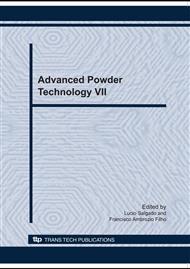p.353
p.363
p.370
p.379
p.385
p.391
p.399
p.405
p.413
Synthesis and Characterization of TiO2 Nanoparticles by the Method Pechini
Abstract:
In recent years, scientific research showed an increasing interest in the field of nanotechnology, resulting in several techniques for the production of nanoparticles, such as methods of chemical synthesis. Among the various existing methods, the Pechini method has been used to obtain nanoparticles of titanium dioxide (TiO2). Thus, this work aims to synthesize and characterize nanoparticles of TiO2 obtained by this method. The technique constitutes in the reaction between citric acid with titanium isopropoxide, resulting as the product the titanium citrate. With the addition of the ethylene glycol polymerization occurs, resulting in a polymeric resin. At the end of the process, the resin is calcined to remove organic matter, creating nanoparticles of TiO2. The resulting powders were characterized by thermogravimetric analysis (TGA) and thermal differential analysis (DTA), X-ray diffraction, absorption spectrophotometry in the infrared, method of adsorption nitrogen / helium (BET method) and scanning electron microscopy. The results obtained in the characterization techniques showed that the Pechini method is promising in obtaining nanosized TiO2.
Info:
Periodical:
Pages:
385-390
Citation:
Online since:
October 2010
Keywords:
Price:
Сopyright:
© 2010 Trans Tech Publications Ltd. All Rights Reserved
Share:
Citation:


